How to grow figs: expert tips on planting, growing and harvesting
Discover how to grow figs with our essential guide – and enjoy the ultimate in sweet fruit indulgence for years to come


Squidgy, fragrant and utterly moreish – once you’ve learned how to grow figs, you’ll be amazed at how easy and enjoyable it can be. Sensual and playful, soft and crunchy, these sweet treasures come in all manner of varieties from creamy green to sultry violet clusters. Mediterranean in origin, yet surprisingly adaptable to more temperate climes, all you need is a sunny, sheltered spot and a little patience – and you too can be sampling these fruity delights.
For those who have only eaten dry and flattened fig rolls, the wonders of fresh homegrown figs can come as a surprise. At once rustic and exotic, they combine far-flung, sun-soaked flavors with simple, direct growing techniques that can be managed in any garden – as long as you get some sunshine. This singular fruit with its dense, dinner-plate shaped leaves also offers a host of health benefits. Stuffed with antioxidants, calcium, potassium, fibre and prebiotics, figs are great for cleaning digestive systems, brightening the skin and preventing cell damage.
So go on, treat your kitchen garden ideas to a cropper that combines highly ornamental appeal with months of sumptuous nibbles. All you need is one year, and a sunny south-facing wall, fence, border or large container to guarantee a sublime and luscious harvest. Here we’ll explain the simple planting, pruning and harvesting secrets to growing a feast of figgy pleasures you can relish for years to come.
How to grow figs: getting started
Learning how to grow figs will reward you with sublime crops that develop in an unusual way. Unlike other fruit trees, the common fig (Ficus carica) develops from flowers that grow internally, so you don’t actually see them. These flowers grow inside the fleshy pods we call the fruits. However, the pod (or syconium) is really a receptacle for the many inverted blooms that have matured inside. Still, it is no less tasty for that!
It’s tempting to assume, with such an unusual cropper, that there may be special growing techniques required? Not so! Figs (part of the Moraceae family) have a reputation for being fickle, but all they want is warmth and sunlight, and plenty of it. Native to places like the Mediterranean, western Asia and California, these crops are dedicated sun-worshippers, and they're a perfect choice if you're looking to add some Mediterranean garden ideas to your plot. The main trick to remember is to feed the fig’s need for sunshine.
As Amateur Gardening’s fruit and veg expert Lucy Chamberlain points out, the fig prefers things hot: 'In its native climes, its closeness to the equator allows it to yield almost continually, producing several harvests a year. In the temperate UK, we usually get one crop in late August.' Still, you only need one tree for a handsome feast; pollination is not necessary, as figs are self-fertile. If you live in a climate with moderate summers, choose a hardy variety. ‘Brown Turkey’ is the most prolific, but also look out for ‘Brunswick’, ‘White Marseilles’ and ‘Rouge de Bordeaux’, says Lucy.
Key with learning how to grow figs is to replicate its need for tougher growing conditions. As well as sunshine, this involves making sure it grows from a confined base – in a container or by a south-facing garden wall or fence. Surprisingly, figs require root restriction under foot to reach their full potential. Examples of 30ft/9m specimens with stunning architectural growth and massive lobed foliage are not unusual, even in small gardens. All you have to do is fool the plant into thinking it is growing on a rocky hillside in the Mediterranean.
Just make sure trees have adequate winter protection, and these hardy trees will grow happily in confined places and a variety of soil types. Fig trees are charmingly low-maintenance and respond well even to small periods of neglect.
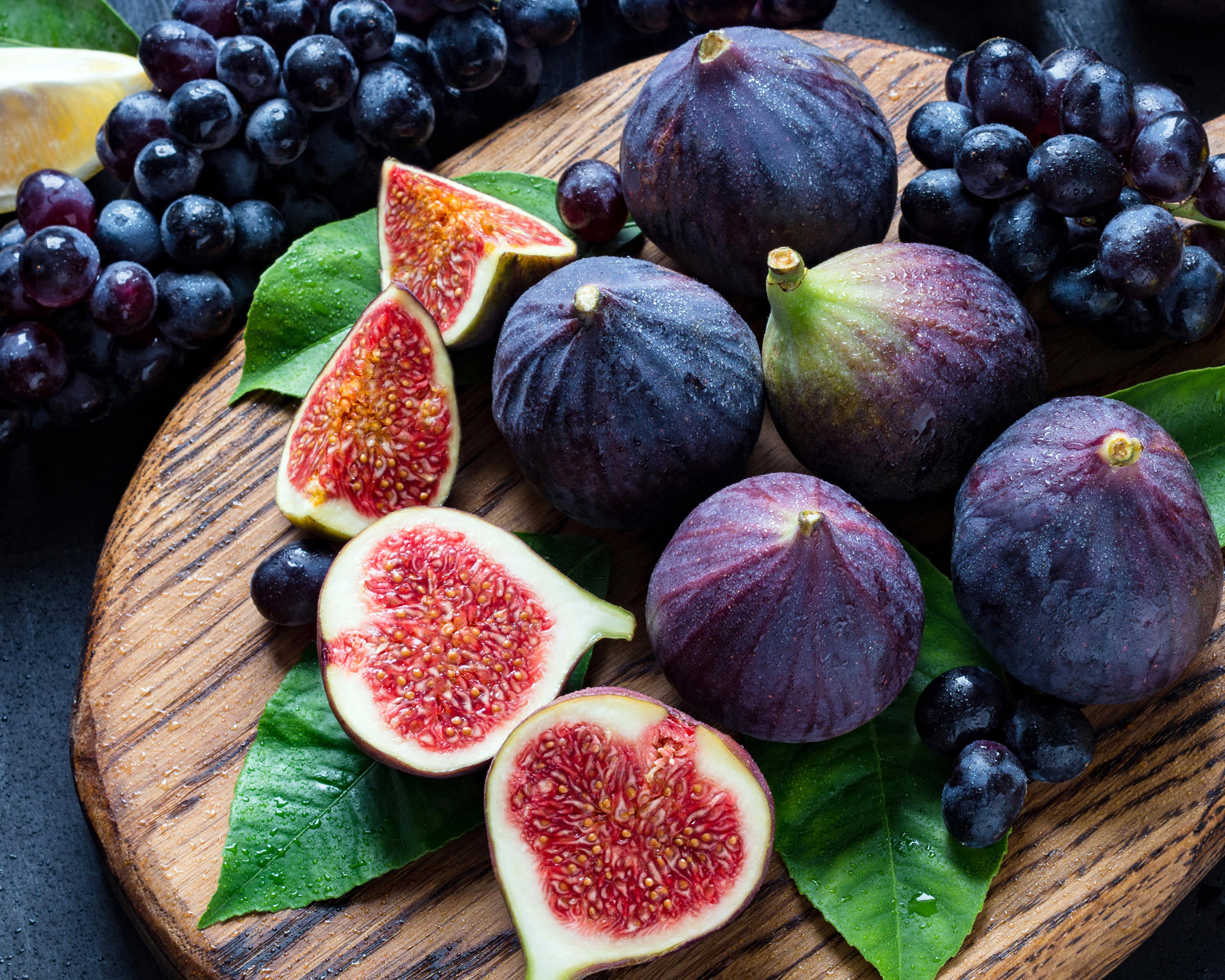
When to grow figs
Now you’re ready to find out how to grow figs, you have another decision to make. Are you going to buy your figs as trees for planting, or would you like to learn how to take cuttings from plants and grow new fig plants as cuttings from your existing trees? Both options allow you to grow homegrown healthy figs – as long as you are savvy to the best growing times and how to increase your rate of success.
There are two optimum times for planting a fig tree: in fall/autumn (September-November) so it has time to establish, or in March-April before things start warming up. Just make sure the ground isn’t waterlogged or frozen, or that there is no risk of frost; pick a mild day for planting, and choose a sheltered spot that will benefit from the most sunshine. Plant near a wall or garden fence for added protection against drafts and chills. You should also plant as soon as you can after buying your fig tree.
If you want to start cuttings from an existing fig tree, the general rule is to do this when the plant is dormant (resting). Late fall/autumn is the best time, ideally before the coldest winter weather bites. You can propagate at other times while the tree is in growth – just as long as you are prepared to take more cuttings as an insurance policy. It normally takes two-four weeks for cuttings to root.
Cuttings are more likely to root if you take them in the autumn/winter dormancy. In fact, figs are amongst the easiest fruit trees to propagate with cuttings. These winter cuttings are known as hardwood cuttings. If you take cuttings in summer, you might find it helps to remove all the leaves and store the cuttings in the fridge for a few weeks before placing them in pots. Using leafy shoots means you need to mist regularly for the plants to root successfully.
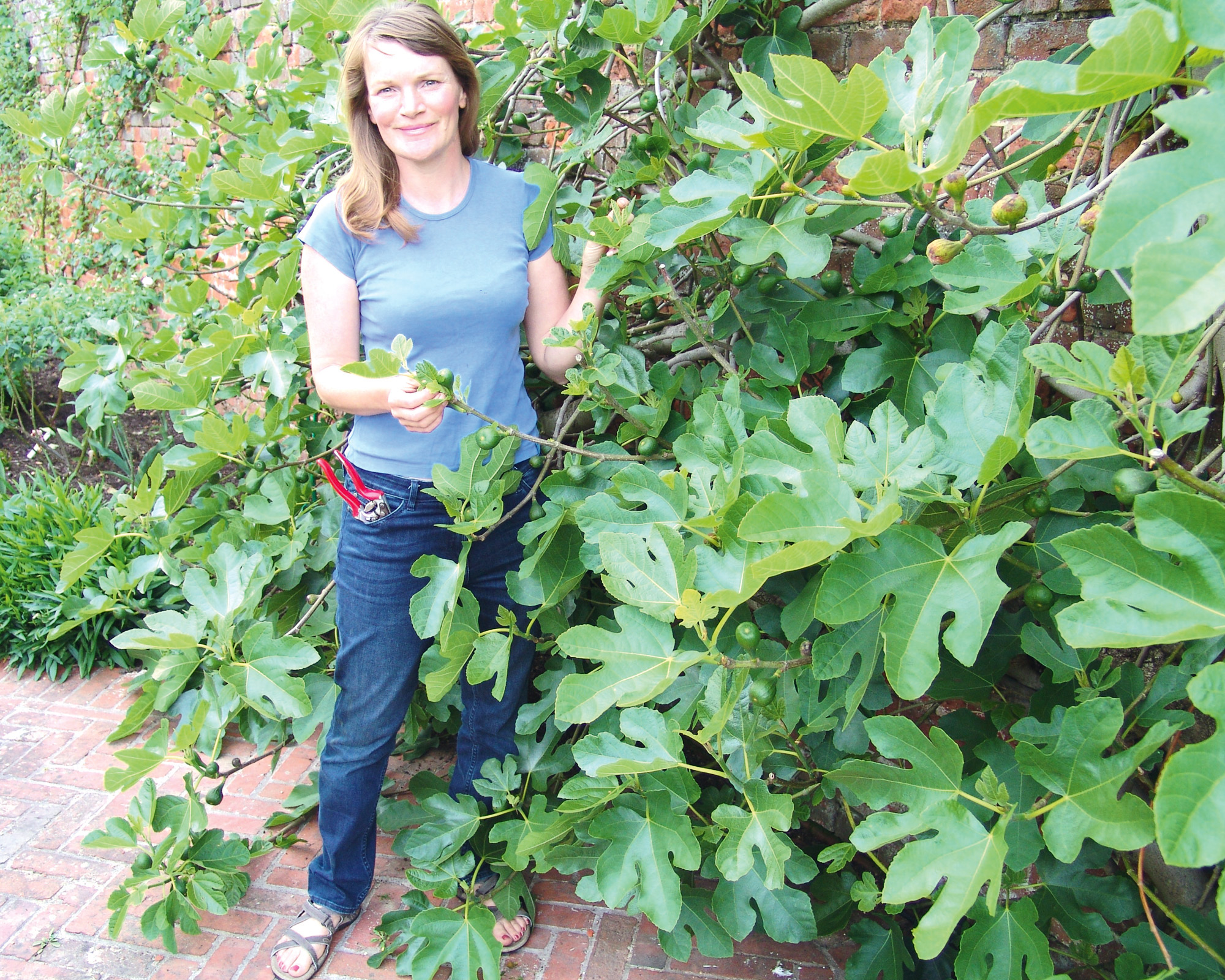
How to grow figs from cuttings
Figs grow quite easily from cuttings, and depending on the variety you choose and the weather in your area, you can expect them to establish well without masses of attention. Shelter and sunshine are key to how quickly they develop and crop. Beyond that, there are no special tricks needed. Give them a moisture-retentive and well-draining soil, or a reasonably big container – and they’re happy.
If growing in the ground, dig over the soil before planting your fig. Mix in some well-rotted garden compost (you can find about composting in our guide).
Our step-by-step guide shows you how to grow figs from winter cuttings. Just decide whether to plant your young fig plants in the soil or in a large container with compost.
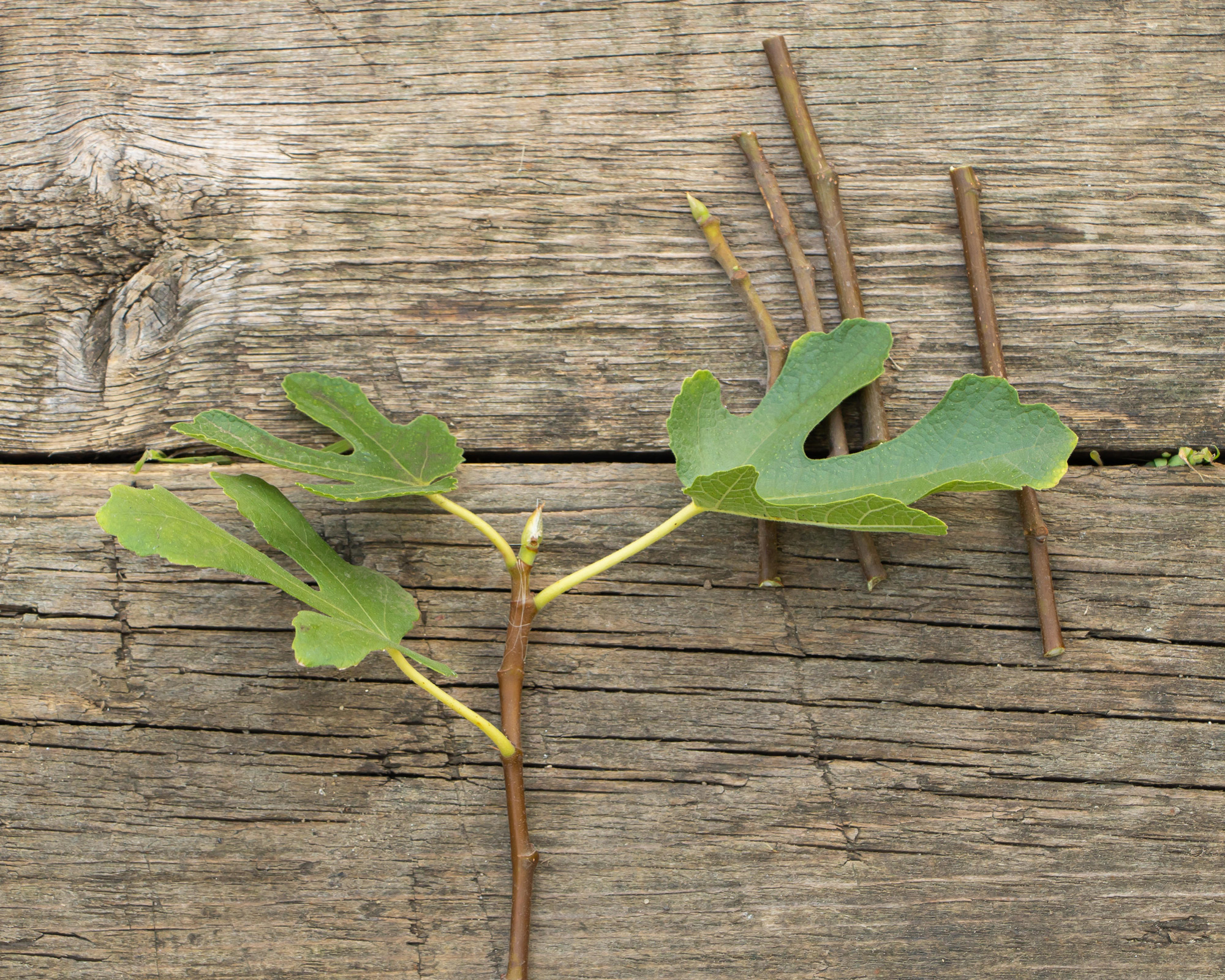
Step one: make winter cuttings of figs
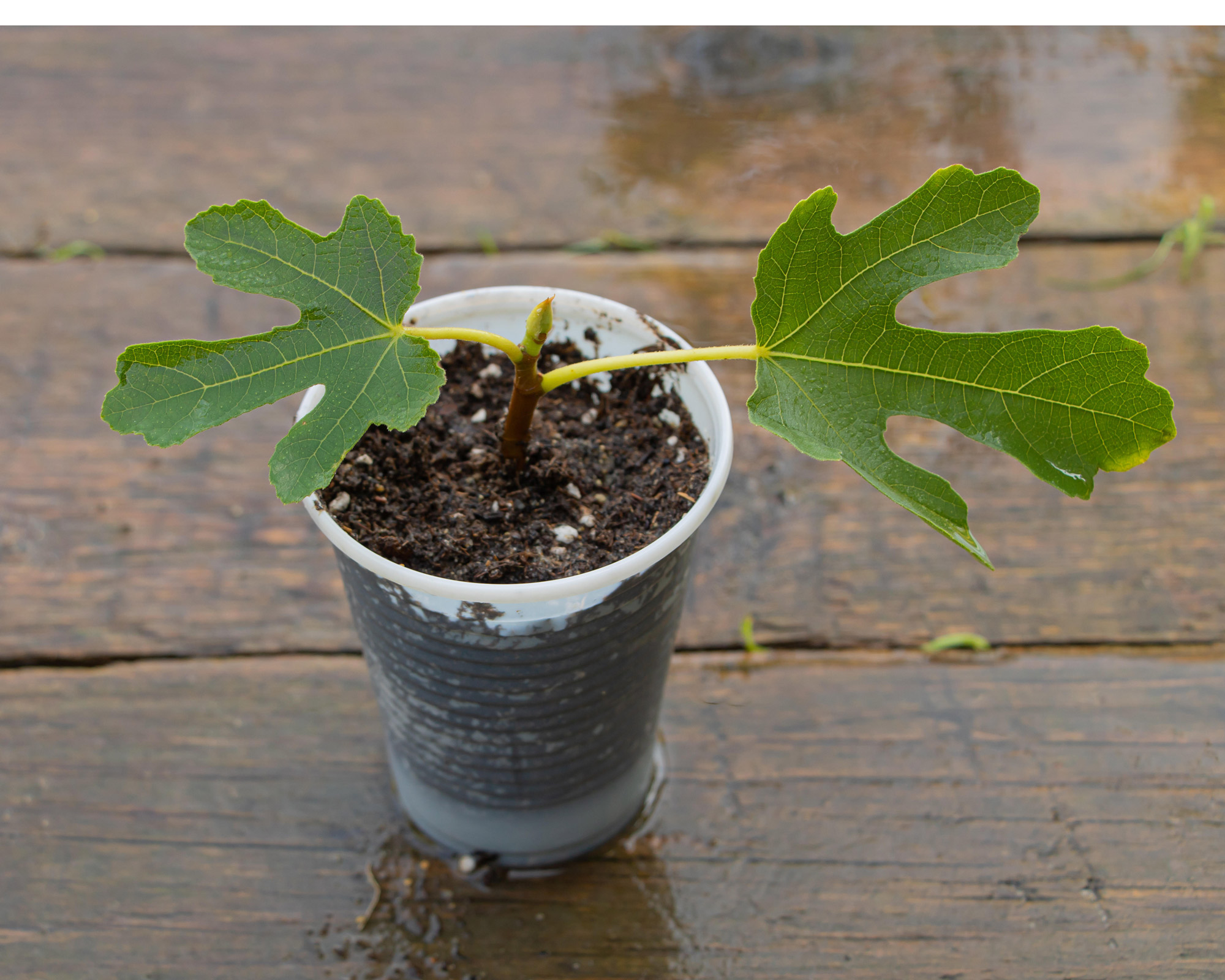
Make sure your best secateurs are as sharp as possible and then you'll also need some small pots or large modular cell trays. Wait until the tree is dormant (from late October) and take hardwood cuttings from stems that are two or three years old. These should be about half an inch in diameter.
Make sure the cuttings are 8-10in (20-25cm) long and have several joints (nodes), with the bottom cut just below one of the joints. We advise taking between six and eight cuttings to allow for failures – if you wind up with more than you need, you can give them to friends.
Cut the bottom end of each cutting to a slant. Some growers like to use a rooting hormone at the base of cuttings – but you can always try without. Place each cutting in a small pot or cell filled with compost. Ideally, you need a growing space that is around 4in (10cm). Water thoroughly.
Place the pot in a bright spot away from direct sunlight and drafts. Make sure the pot does not dry out and keep compost slightly moist so the cuttings root. It can help to spray cuttings regularly to help raise humidity levels. In a few weeks, you should see signs of leaf growth.
Step two: pot on your fig plants

Between four and six weeks after starting off your cuttings, you should be seeing signs that your figs have rooted. The big giveaway is if you see a small leaf developing. When you get the sense this leaf is growing and is in good health, you can put your cutting in a slightly larger container.
We cannot stress enough, though, how important it is to pick a garden planter that is just slightly bigger. At every stage of potting on your fig, remember what we said about root restriction. This is just as important at the early stages of plant growth when the roots are very young.
So choose something that is just a few inches wider in diameter. Fill up the new container with fresh, well-draining compost that is slightly moist. Make sure your cuttings are upright and secure. It may be necessary to pot on a few times before planting, depending on the rate of growth and weather conditions.
It is not unusual to keep figs in pots for several months before planting. During this time, monitor the young figs daily and make sure they are kept watered. Where the weather permits, you can try putting the pots outside – but make sure they are not exposed to harsh drafts or frosts.
Want to know more about the kinds of fruit trees you can grow in pots? Read our guide to the best fruit trees to grow in pots to find out which varieties are ideally suited to container growing.
Step three: plant your figs in the ground
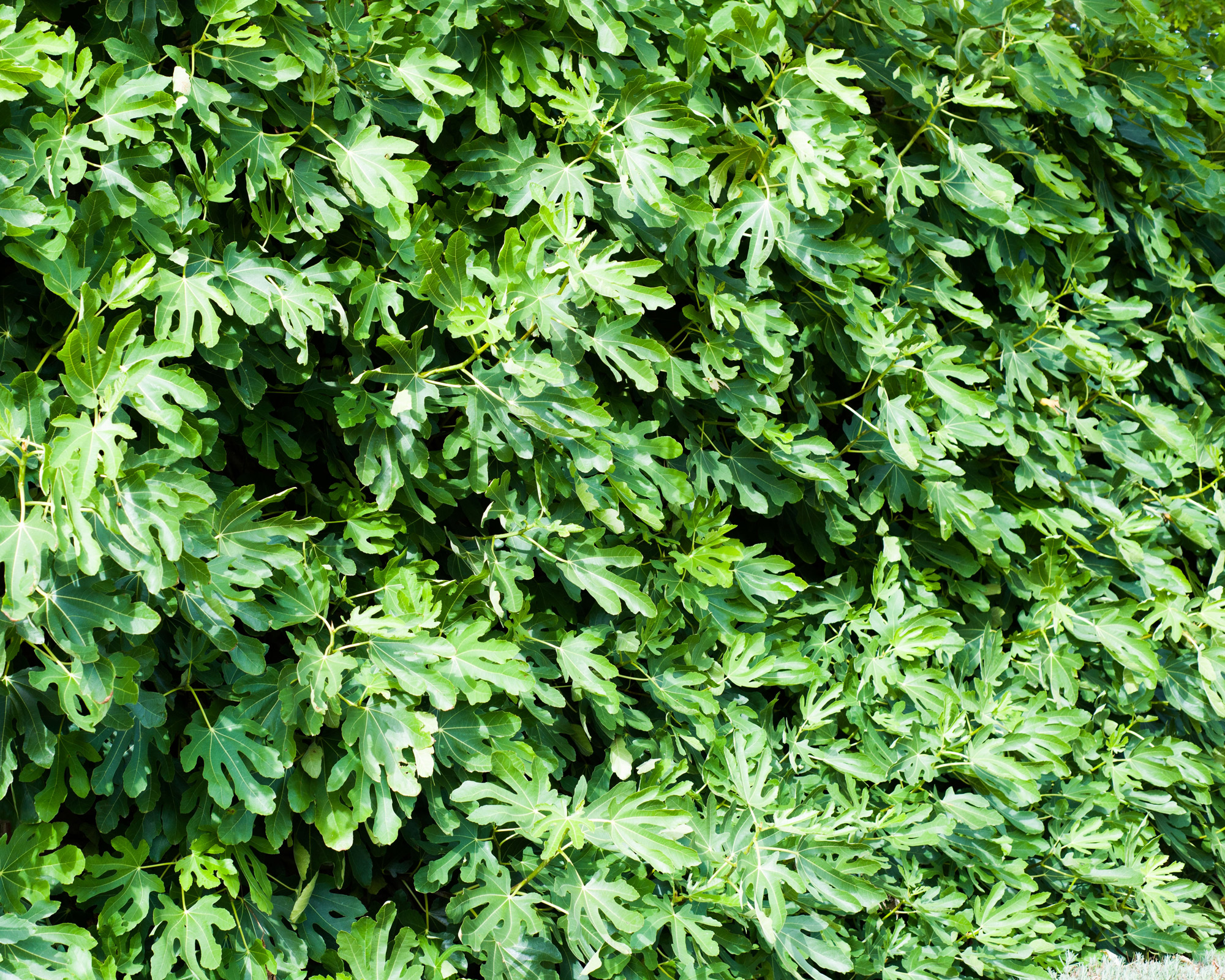
Once your fig plants are a few months old, you can transplant them outside. Late winter or early spring (March/April) is a good time to do this, assuming you made winter cuttings – if you made summer cuttings, wait until November. Ideally, it’s a good idea to choose a day that is overcast, but not cold.
Hopefully your planting site will be in a sunny spot and sheltered to protect the young plant as it is getting established. Lucy Chamberlain recommends a south or west-facing wall for first-time fig growers. This will provide the optimum growing conditions for young plants and maximize sugar levels in ripe fruits. Walls are also great for training your figs. Make sure the soil is moisture retentive and free draining before planting.
Don't forget about the importance of restricting root growth – and start as you mean to go on. That way, the fig will ultimately put more energy into fruiting instead of cultivating foliage. To help with this, plant your young figs outside into ‘pits’ which deliberately restrict growth (you can also house the plants in root control bags or 2ft/60cm-wide pots before plunging them in the ground).
Dig out a hole 2ft (60cm) deep and wide in your planting site. If planting near a wall, allow an 18in (45cm) gap for rain to fall. Line the sides of the planting hole with vertical paving slabs. Let these slabs stick 1-2in (2.5cm-5cm) above the soil surface. Line the base with broken bricks or rubble. This will help with drainage while discouraging roots from running rampant.
Fill the hole with soil mixed with compost or well-rotted organic matter. Soak the plant in water. Add mycorrhizal fungi to the roots to help the plant establish. Plant the tree, then firm the soil and water thoroughly. Make sure the paving slabs stay a little above soil level. If planting more than one fig, give each young tree 25ft (7m) space. Trained figs need a series of horizontal wires spaced a foot (30cm) apart to support young branches.
To make sure your figs are happy, keep checking your soil is moisture retentive and free draining.
Step four: planting figs in containers
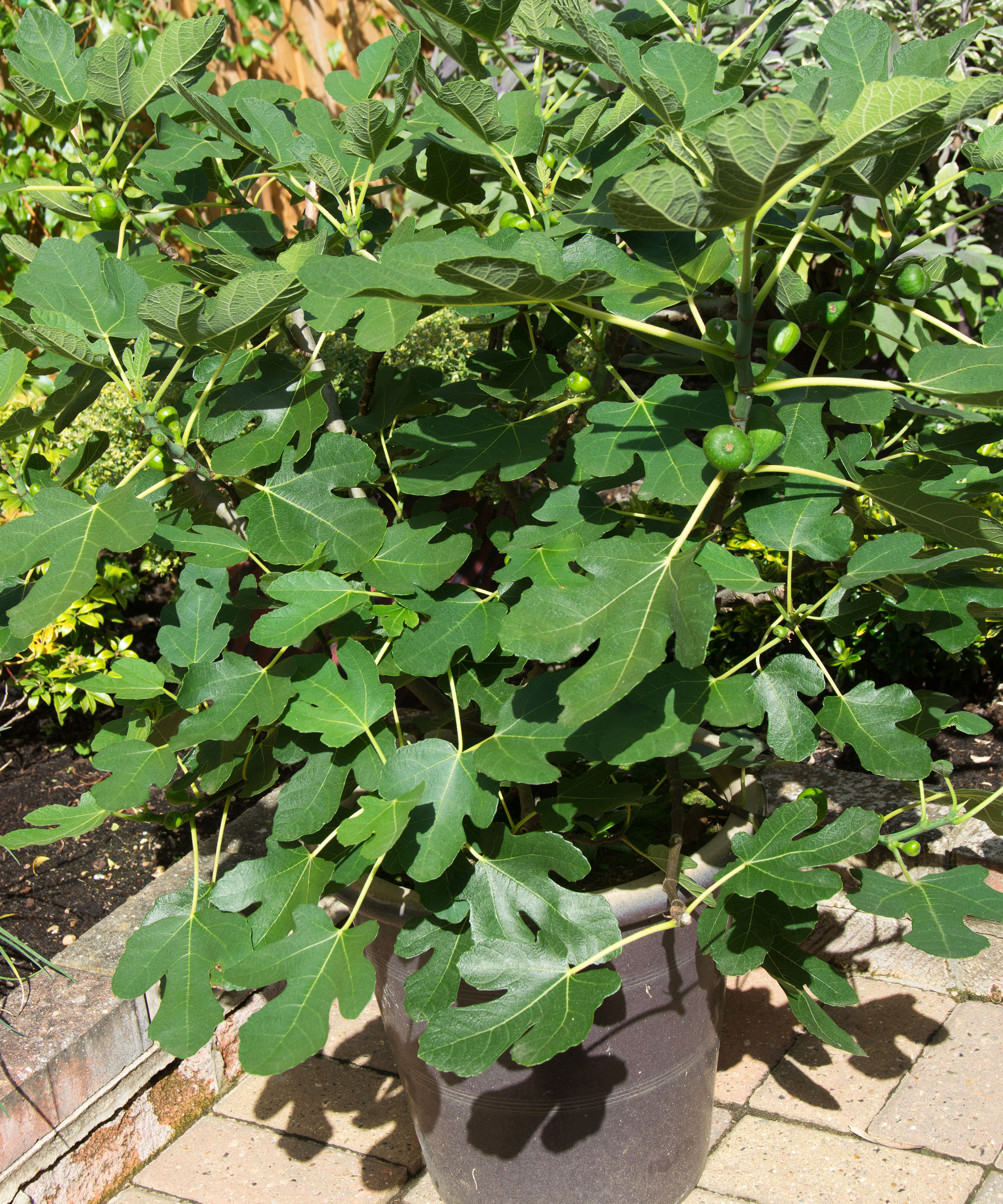
If you're a fan of growing fruit in pots, you can keep your small fig trees in large containers on a sunny patio. As well as ensuring root growth is restricted – which is key to fig cropping success – growing your plants as part of your container gardening ideas means you can easily move them undercover for the winter months. As per previous steps, remember to select a container that is only ever incrementally one size larger than the previous one (ie a couple of inches/5cm wider in diameter than the last).
Container-grown plants can be planted at any time, but spring (late March-April) is best to make the most of the growing season. Use a good-quality John Innes No3 compost or multi-purpose, mixed with one third grit or perlite. Also make sure the pot has drainage holes at the base.
Place crocks over these holes to help with drainage. Fill around the plant with compost and make sure the plant is well anchored, then remember to keep watering plants well. If planting in spring, add general-purpose or high-potassium fertilizer pellets or liquid feed (alternate between the two in spring and summer). Move the pot into position outdoors. Placing on pot feet will help with drainage. Keep watering regularly during this first season of growth. Re-pot no more than once every two years.
Where to grow figs
A key part of mastering how to grow figs is to remember the importance of replicating its native Mediterranean conditions where you can. You will increase the chances of prolific and healthy fruiting if you pick a sheltered spot against a sun-drenched wall or fence (or underglass in a greenhouse, if that is more reliable). The more sunshine your fruits get, the sweeter they will be.
It has been said that a fig tree likes its feet in water and its head in the sun, as the soil must stay cool for it to flourish. This doesn’t mean figs like waterlogged soil, however. Grow in moisture-retentive yet well-draining soil. This can be any pH, depending on variety, although figs seem to do their best in slightly alkaline conditions. Alternatively, grow in a large, deep container – again, against a house wall or protected patio spot. This can be moved to a frost-free greenhouse in winter.
Consider trying companion planting to help boost your fig crops too. Strawberries are good for ground cover and enjoy the dappled shade afforded by figs. Comfrey, marigolds and mint can also be beneficial for releasing essential nutrients.

How to care for figs
The main thing to remember as you learn how to grow figs is that they require different care at different ages. With very young trees, you must make sure the soil is kept moist. Watering is particularly critical through the growing season – and it needs to be regular to prevent fruit splitting or dropping. Hydration is key to keeping your figs happy and healthy.
A balanced feed (ie fish, blood and bone) or high-potash topdressing is beneficial in spring, as is mulching with well-rotted compost, composted bark or manure. This layer of mulch in spring helps to keep the ground cool and moist as the temperature rises. It’s best not to apply high nitrogen feeds, which promote leaf growth rather than flower bud development.
You should find that older trees are far more drought tolerant and need less attention. That said, any container-grown plants should not be allowed to dry out. They need a drink daily on warm, sunny days, plus regular feeding in early summer.
When figs start to develop on healthy established trees, you can boost productivity and growth by applying a potassium-based liquid tomato feed every two weeks. As fruits swell, keep well watered in summer. In autumn, remove any figs that are large but unripe – but leave any small pea-shaped figs in place for the following year.
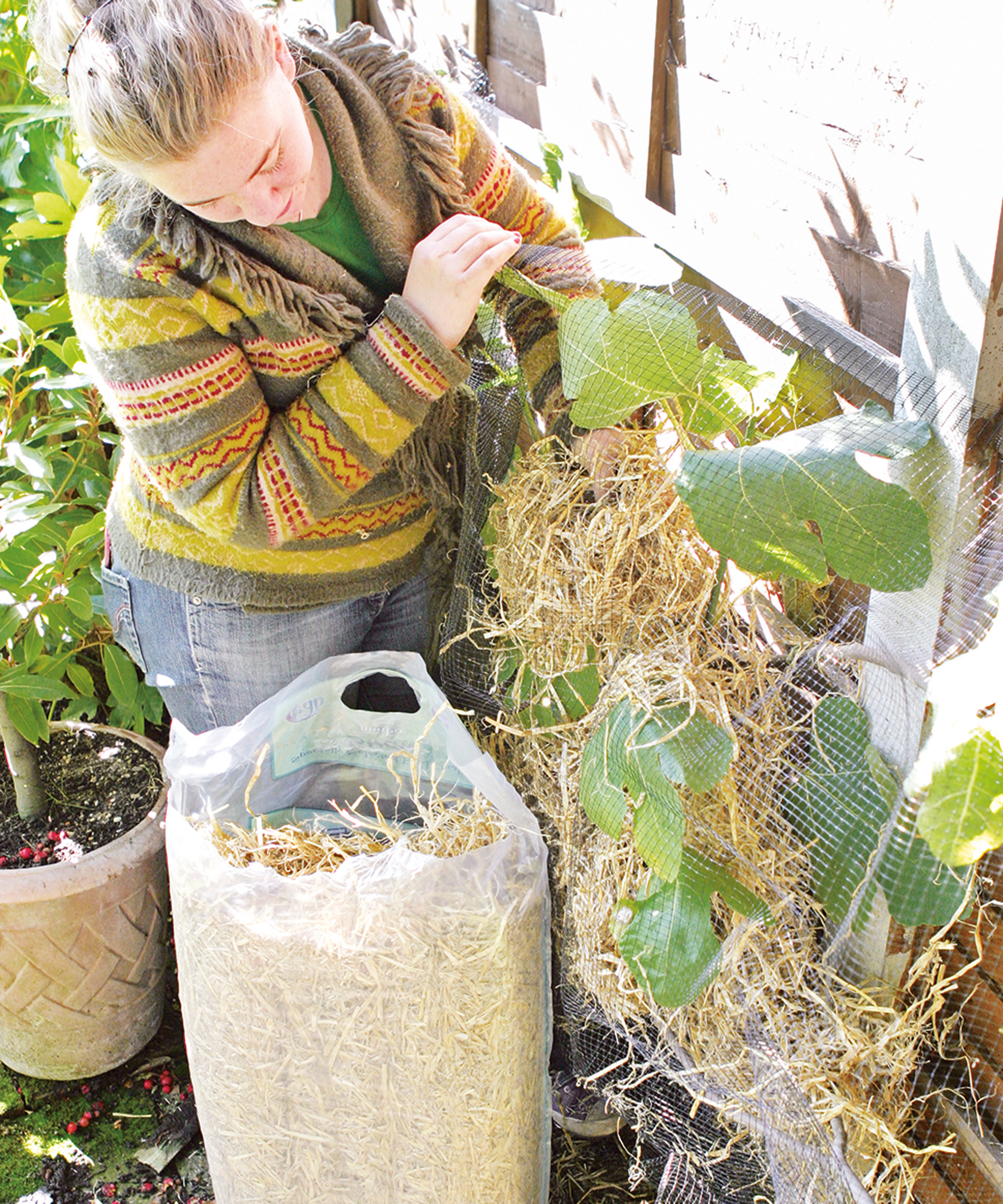
Learning how to protect plants from winter is important, especially for younger trees. When the leaves drop, cover with horticultural fleece. Alternatively, figs standing against a fence or wall can be insulated with straw held in place with netting, says Lucy Chamberlain. This will ensure that very young fruits survive the brunt of winter (remove at the end of spring).
Container-grown figs can be moved under glass for winter. Choose a cool but frost-free spot like an unheated greenhouse. It’s also smart to cover the pot with bubble wrap or hessian. Remember to repot every two years (or replace with fresh compost). And don’t forget: root restriction reaps dividends – so don’t make the next pot too much bigger.
Pruning fig trees should be done twice a year, once in late winter and once in midsummer. They grow quickly, so this keeps their shape and size in order. It also allows you to maintain their open and airy structure, so plenty of sunlight can reach through. What's more, pruning can encourage new fruitlets to develop at the right time, so you can enjoy a maximum yield when it's time to harvest.
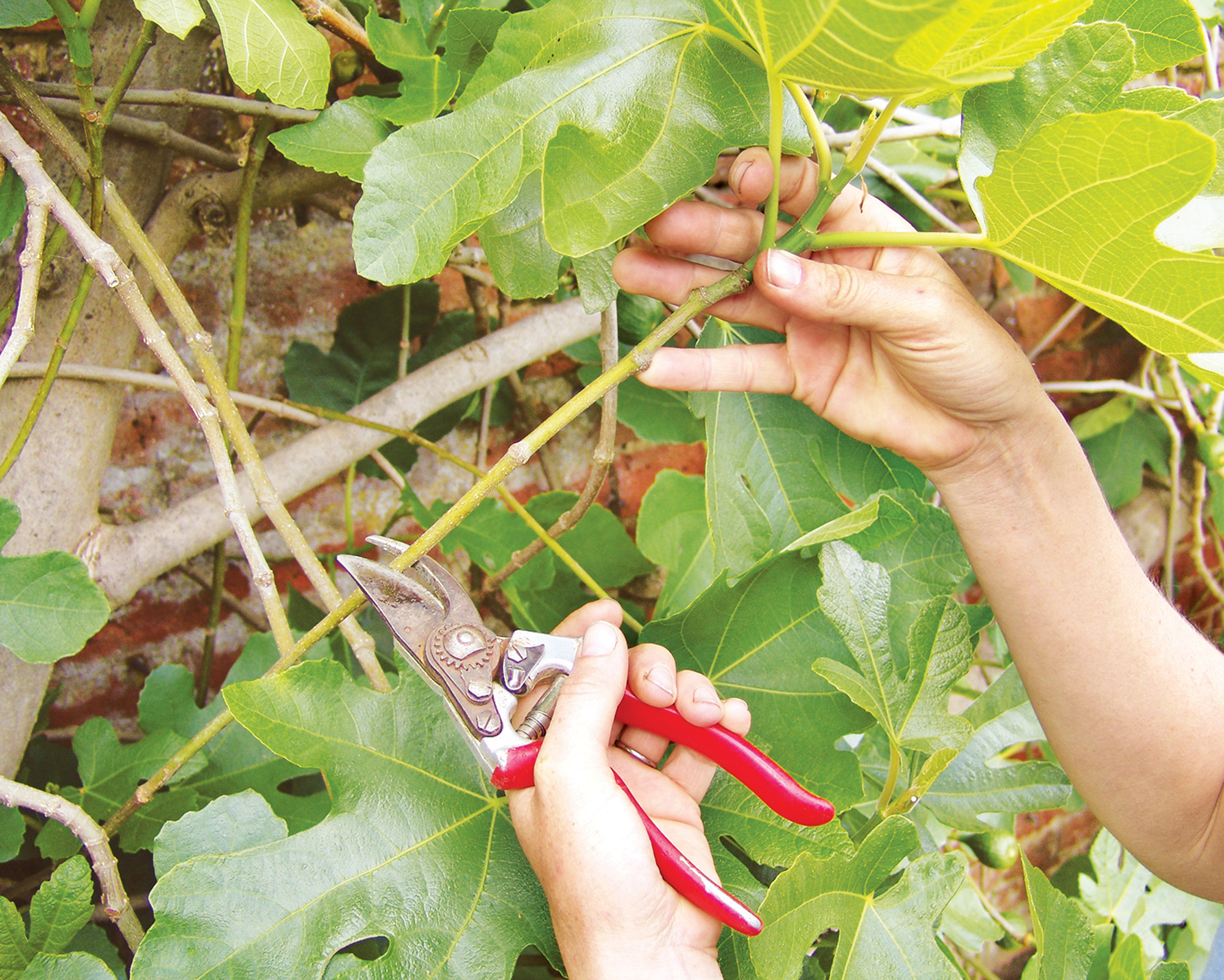
Tackling fig pests and problems
The good news with learning how to grow figs is that – apart from monitoring sunshine and moisture levels – there isn’t a lot to worry about. Problems are minor when compared with other fruit trees and cropping plants. The main concerns you might encounter will be trees that either don’t produce figs or produce figs that don’t ripen as or when they should.
First of all, it’s worth bearing in mind that a young tree can take a few years to reach the point where it can sustain a crop. If your tree doesn’t produce figs in the first couple of years, try not to get despondent. Fig trees need a long root development phase. If the soil is well watered in those first two years after planting, this waiting time is natural. If you want to give your tree a boost in spring, you can add a little fertilizer. After that, all you can do is keep watering your tree – and wait.
Another possible issue is that you see fruits, but they don’t ripen fully or at all – or they drop before they do. This could indicate a lack of water or a lack of sunshine at a crucial moment in the ripening phase. In this case, again, give your tree a boost in spring with some fertilizer – and try again. Over time, a fig tree develops more roots that are strong enough to find all the nutrients it needs. Make sure your tree isn’t exposed to drafts or chills, as this can check growth, and transplant if necessary.
This aside, there are few pests to worry about. It helps to cover your tree with mesh netting or horticultural fleece around fruiting time to deter pigeons and squirrels. Also, if you grow your figs under glass, keep an eye out for glasshouse red spider or two spotted mites. These pests thrive in hot, dry environments. Problems manifest as mottling in the leaves, discoloration, webbing, or premature leaf drop. You can minimize the risk by misting regularly to increase humidity.
Figs are also attractive to wasps, thanks to their high sugar content. Make sure you harvest figs as soon as they are ripe, and check there are no windfalls that might entice unwelcome buzzing guests. Again, you may find netting can help alleviate this problem as fruits become softer and sweeter. Read our guide on how to get rid of wasps for more ways to combat this common pest.

When to harvest figs
In native climates, fig plants can develop multiple times over the course of a year. In more temperate regions like the UK – unless you are growing under glass – outdoor fig trees tend to produce one harvest a year, between late August and early October (with fruits forming May to September). There are some exceptions (‘Madeleine des Deux Saisons’ can fruit in June and September), so check with your supplier.
In late spring, embryonic fruitlets from the previous autumn will kick into life and start to ripen. By high summer, assuming the sun worked its magic, you can expect a mouthwatering feast.
There are a few excellent tell-tale signs figs give to let you know they are ripe. If you give them a gentle squeeze, they feel soft and the skin may start to split. Depending on variety, colors deepen, stems bend and fruits hang down. You may even see a drop of nectar near the base of the fruit. This is your cue to consume them – fresh from the tree and warm from the sun. Or, if you fancy, they can be dried or turned into preserves.
Amateur Gardening’s Lucy Chamberlain outlines the three key signs that your figs are ready for picking:
- Drooping The majority of unripe figs protrude upwards along the branch where they’re growing. As the stalk softens and flesh ripens, the fig will hang downwards. This is often the very first sign of maturity.
- Sugar liquid The base of the fruit bears a tiny opening (often colored beige). As sugar and water levels peak, a clear sticky liquid may be seen emerging from this area; this is described as a ‘weeping eye’.
- Skin splitting As figs ripen fully, they take on a lot of water. With skins becoming increasingly soft and fruit volume increasing, you’ll often see skins beginning to split. This is a big sign that harvest is imminent!
At the end of this harvest season, you may find there are large unripe fruits still on the tree. These are not likely to survive the winter and should be removed before the end of autumn. Hopefully, you will also see tiny embryonic fruits. These pea-sized growths should be left on the tree to overwinter and ripen the following summer – when they will form the next harvest feast. 'It’s these fruitlets that give us our August crop, so the more of those, the merrier – remember to protect these fruitlets from harsh frost,' says Lucy.
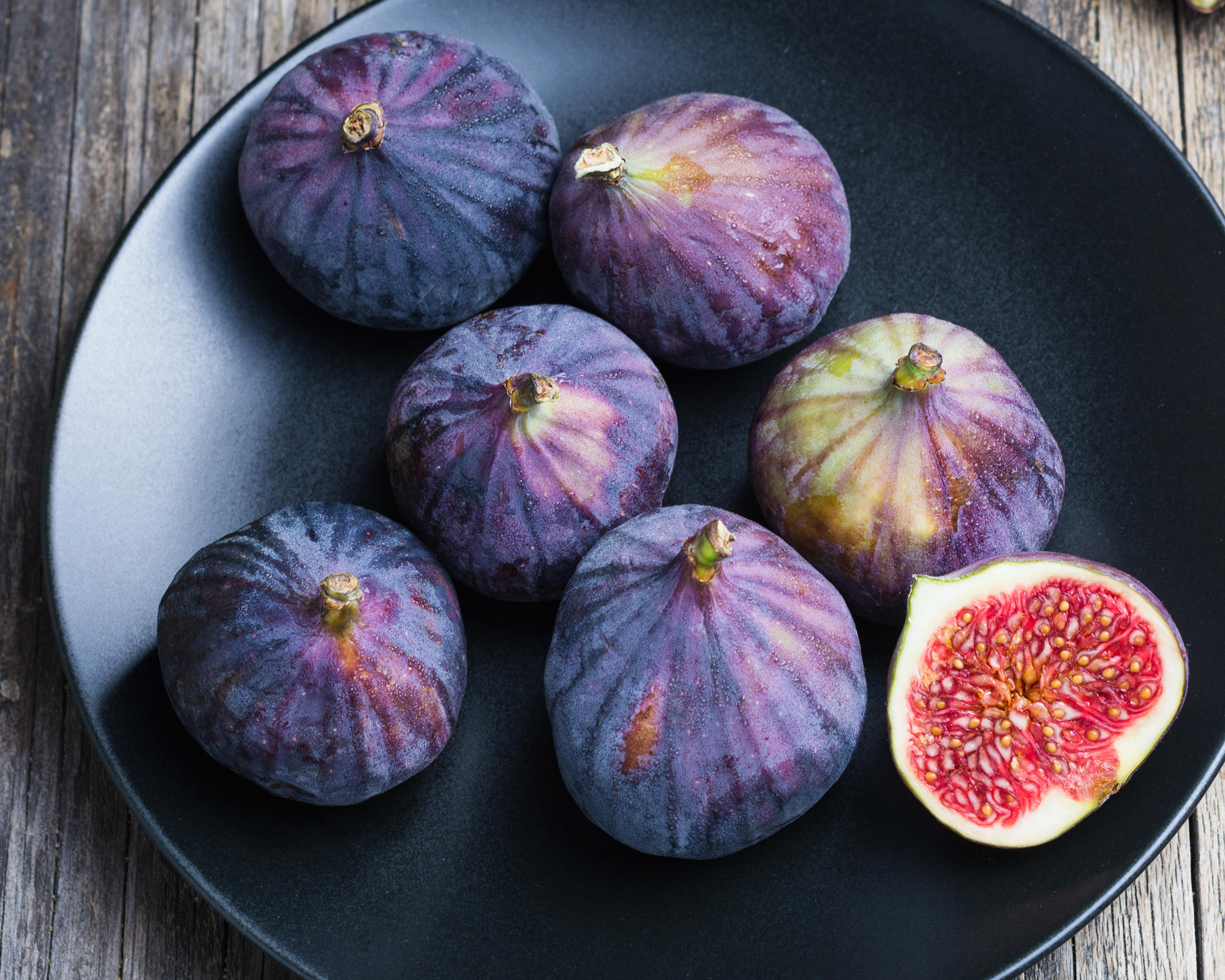
5 of the best fig varieties to try
Now you know how to grow figs, here are some of the tastiest and most reliable varieties for you to try in your potager garden:
1. ‘Brown Turkey’

This classic mid-season fig is a heavy cropper, producing pear-shaped fruits with purplish skins, soft red flesh and a candy taste. A self-fertile fig, ideal for a large container that would work well for any patio gardening ideas.
It can also grow successfully in cooler areas. ‘Brown Turkey’ figs can grow as tall as 20ft (6m), but are happy if pruned to a compact or wall-trained shape. Adaptable to many soils, and tolerates drought for brief periods. Harvest: August-September.
2. ‘Brunswick’
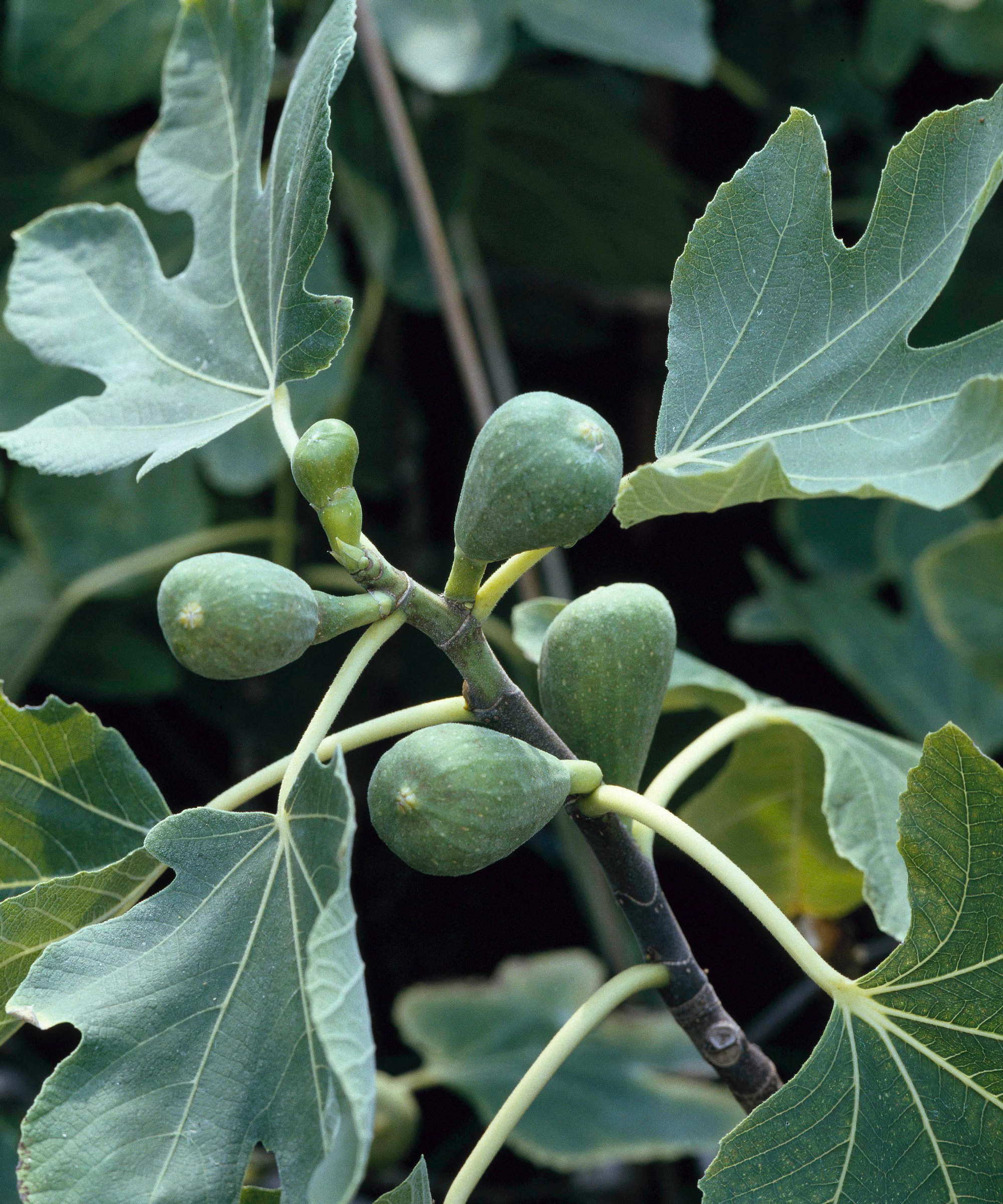
Another fragrant, self-fertile, hardy fig that does well outdoors in cooler, temperate regions. This generous cropper develops long-lobed leaves and impressively big, pear-shaped fruits with pink flesh and a rich, sweet flavor. Thrives in a sheltered, sunny spot against a south-facing wall or in a big container. Add garden compost to the planting hole and topdress annually. Harvest: August-September.
3. ‘Madeleine des Deux Saisons’
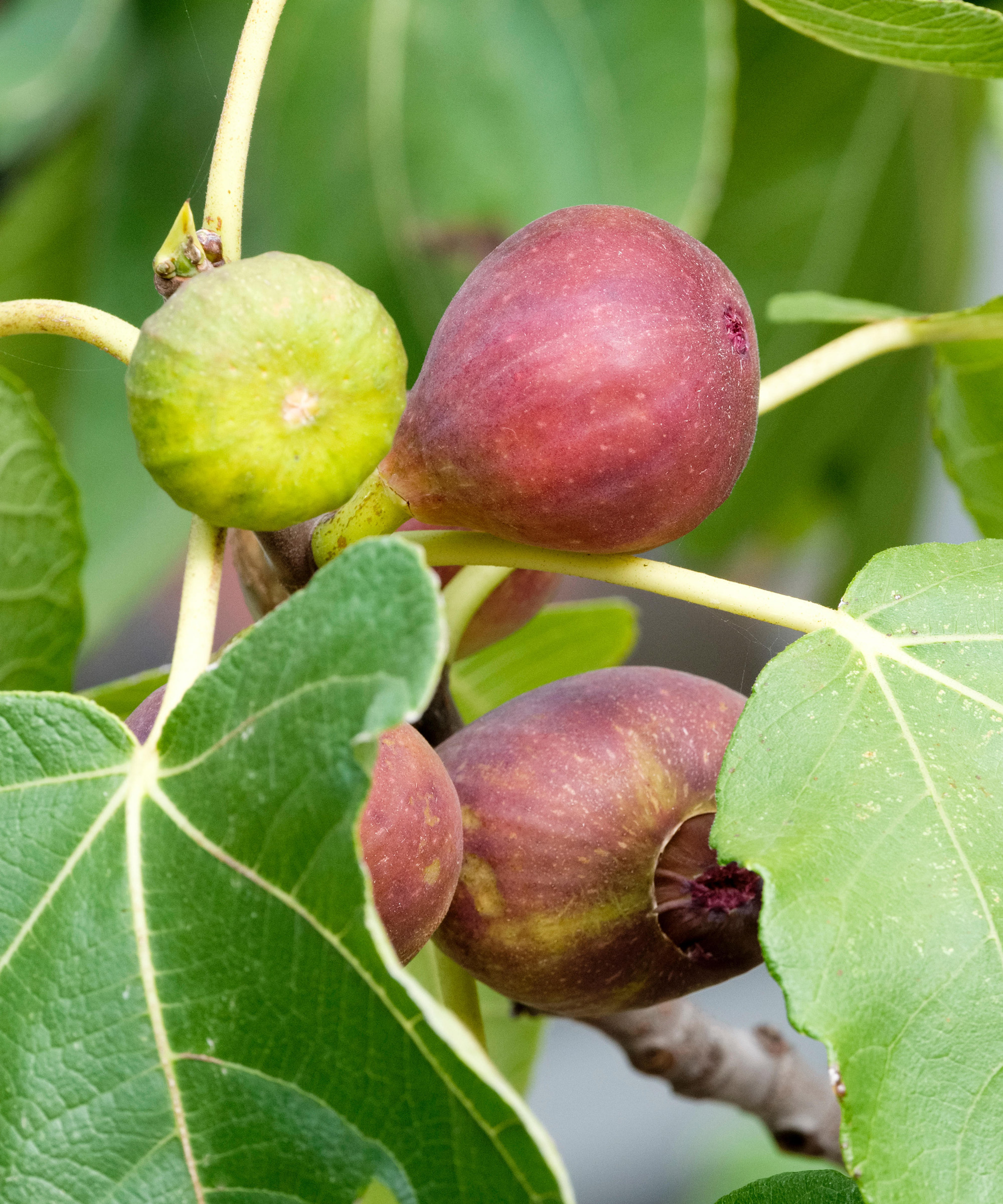
This early-ripening heritage fig (meaning ‘Madeleine of Two Seasons’, also known as the Madeleine Fig Tree), is capable of producing two crops a year in hot summers. Being super hardy, this abundant ancient French variety is self-fertile, so is ideal for small gardens. Fruits are red-brown, spherical and sweet with pink flesh. Can reach 3m (9ft) in slightly alkaline soil. Harvests: July and September, depending on weather.
4. ‘Panachee’ (aka ‘Striped Tiger Fig’)

Grown as a large shrub or a compact tree, the Tiger Fig is so-named because of its brightly colored stripes. Inside, the fruit is bright red and tastes like strawberries. Reaching 2-3m (7-10ft), this highly decorative, hardy and self-fertile fig is one of the more ancient varieties, traced back to the 1600s. Recommended for a south- or west-facing position, it is a reliable cropper with good cold-resistance. Harvest: August-September.
There's more suggestions for the best trees for small gardens in our guide.
5. ‘Violette Dauphine’
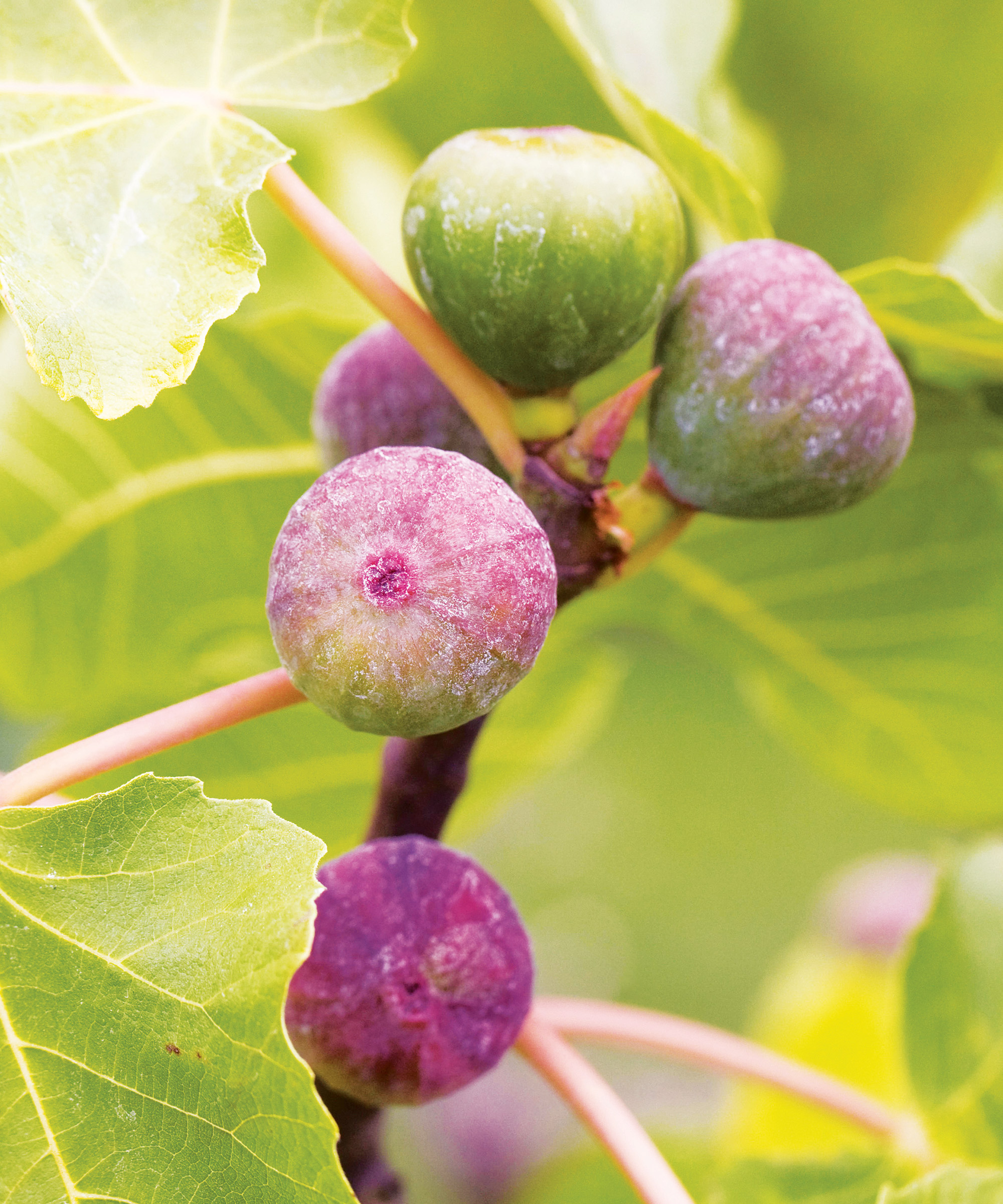
Similar to ancient French Variety ‘Madeleine des Deux Saison’ (above), this hardy, fragrant and productive fig is better suited to UK climates and has impressive disease resistance. It’s also fast-growing, as well as self-pollinating. Producing large, flushed violet figs with sweet pink flesh, it is happy against a sunny wall. It also grows comfortably in containers up to 15 litres, reaching 3.5m (11ft). Harvest: July-October.
Where to buy fig plants and trees
When thinking about how to grow figs, remember the tree needs sun and shelter. Check the maximum size of any tree you want to buy, think about the space available, and consider smaller varieties for modest gardens. You may also wish to contact a specialist fruit tree supplier for buying advice. Luckily, you can buy fig trees from a wide range of online suppliers. Use our quick links to head straight to leading suppliers.
Where to buy fig plants in the UK:
- Shop fig plants at Amazon
- Shop fig plants at Crocus
- Shop fig plants at Dobies
- Shop fig plants at Pomona Fruits
- Shop fig plants at Primrose
- Shop fig plants at Suttons
- Shop fig plants at Thompson & Morgan
- Shop fig plants at Waitrose Garden
- Shop fig plants at You Garden
Where to buy fig plants in the US:
Can you start fig cuttings in water first?
As part of learning how to grow figs, it’s well worth taking a few cuttings at once, in case some don’t take. For this reason, there’s nothing to stop you starting a couple of cuttings in water to root – it can be interesting to try this for a comparison with your other cuttings. Your success rate may be higher if you are prepared to mix and match propagation processes.
Some growers swear by starting figs in water first in order to root, then carrying out the rest of the propagation process as described above. We don’t think you need to root in water first – but it’s worth trying it both ways to see what works best for you.
- Try a few cuttings made during the dormant winter period. Use healthy stems cut from the tree, as described above, with sharp secateurs.
- Make sure each cutting has at least four or five buds.
- Remove an inch (2.5cm) of bark from the base.
- You may want to add some rooting hormone before placing in water; this is up to you.
- Place in a jar filled with clean rainwater. Put the jar near a window out of direct sun.
- Change the water twice a week to give the cutting as much oxygen as possible to develop roots. You should see these emerge within a few weeks.
- After 40-45 days, once the roots are big enough, you can pot up your fig cuttings.
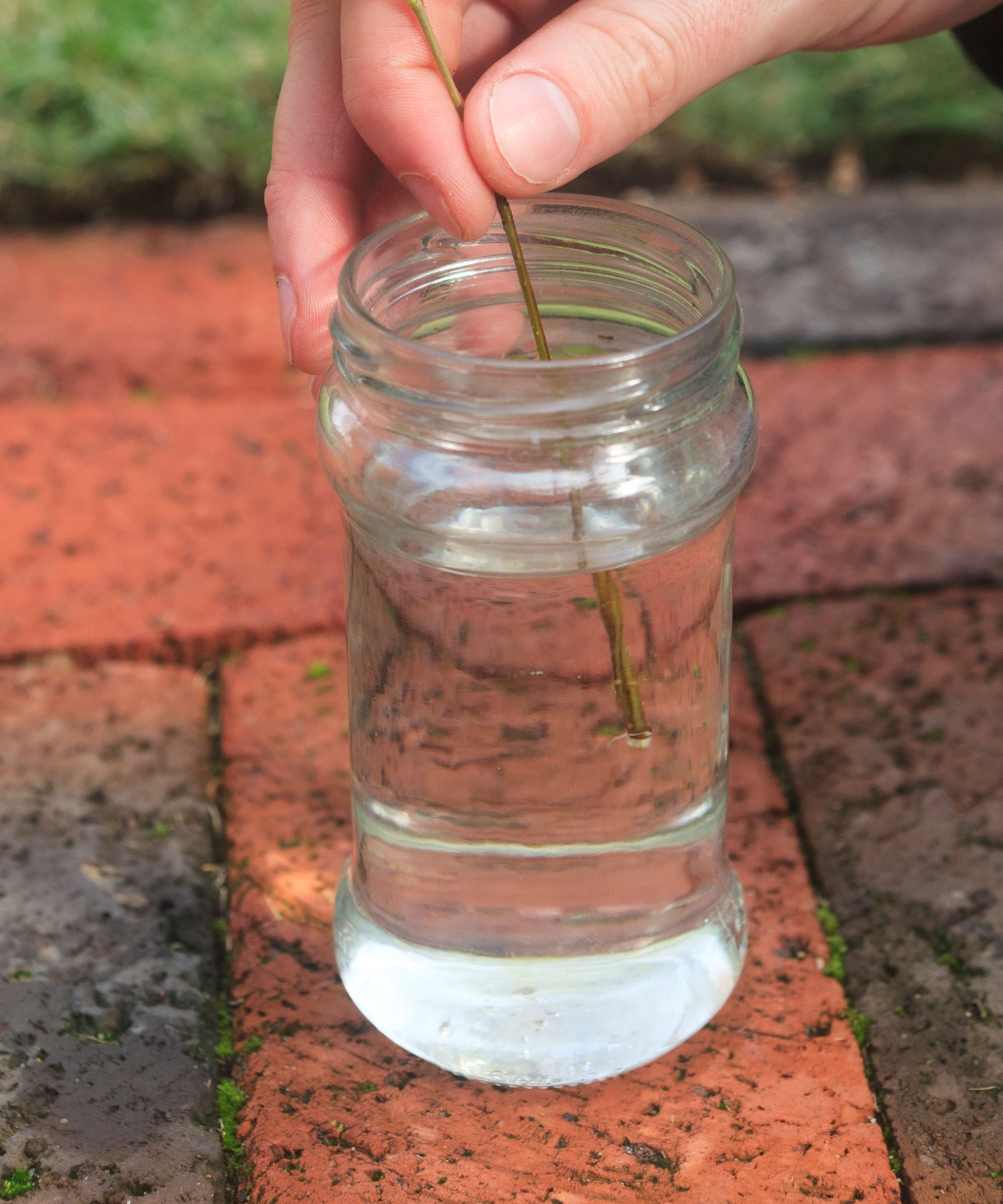
Can you grow figs from seed?
Given how straightforward it is to master how to grow figs from propagation, you may be wondering: why not just start some off from seed? We aren’t saying this doesn’t work: you can collect seeds and germinate some. However, it’s a fickle process. The chances are that the figs won’t grow ‘true’, which means they won’t be the same variety as the parent. The only way to get a true replica is to do a cutting.
The other risk with starting figs from seed is that there is a chance you might not produce a female plant. If you produce a male plant, you wind up with a tree that produces small, inedible fruits. Only females go on to develop the figgy fruits we know and love. That said, if you’re not all that bothered about the fig variety and feel like experimenting, germinating fig seeds from fresh fruit can be fun.
Here's how to do it:
- Cut a fig in half, scoop out the pulp and seed, and soak for two days. Healthy seeds sink to the bottom of the glass or jar.
- Place pinches of seeds in cells. They should germinate in one-two weeks; keep them moist and warm.
- When the seedlings have two sets of true leaves, move to individual pots.
- Keep in moderate light for a couple of months. It’s also a good idea to provide humidity by placing the pots on a saucer of pebbles filled with water, or by misting the plants.
- Add diluted houseplant food at the six-month mark, or in spring. Move out in summer.
Looking for a fruit that is easy to start from seed? Our guide on how to grow watermelon will help you grow a surprisingly simple fruit from scratch.

How to make fig jam
You might find it hard to hang on to your figs long enough to turn them into preserves. They are so delicious eaten fresh from picking, you may not be able to resist! However, if you can, it’s a nice treat to cook up a quick fig jam for your stock cupboard or fridge – or as a gift for a friend. It’s a lovely accompaniment to both sweet and savory dishes, particularly cheeses, so it’s well worth the effort.
- You need a pound of figs, a cup of water, two tablespoons of lemon juice, a tablespoon of vanilla extract, three-quarters of a cup of granulated sugar and a cinnamon stick (optional).
- Add the fig flesh, sugar, lemon and vanilla to a pan. Cook over a medium heat, stirring until the sugar dissolves and the figs are juicy.
- Add water and simmer, stirring until juices thicken. This could take 30 minutes to an hour.
- When the liquid is sticky and drops heavily from a spoon, leave to cool (removing the cinnamon stick if used).
- Spoon into jars with airtight lids. Store in the fridge for two months. Want to grow other fruits that can be preserved as jams as well as eaten as fresh fruit? Find out how to grow strawberries with our guide.


As assistant editor of Amateur Gardening magazine, Janey's gardening passion was fostered from an early age, when her amazing mum had her deadheading hydrangeas, mulching roses, and propagating strawberry plants from runners for school open days. She's also taken part in lots of conservation and rewilding projects for the RHS and TCV as a way of exploring her horticultural horizons.
